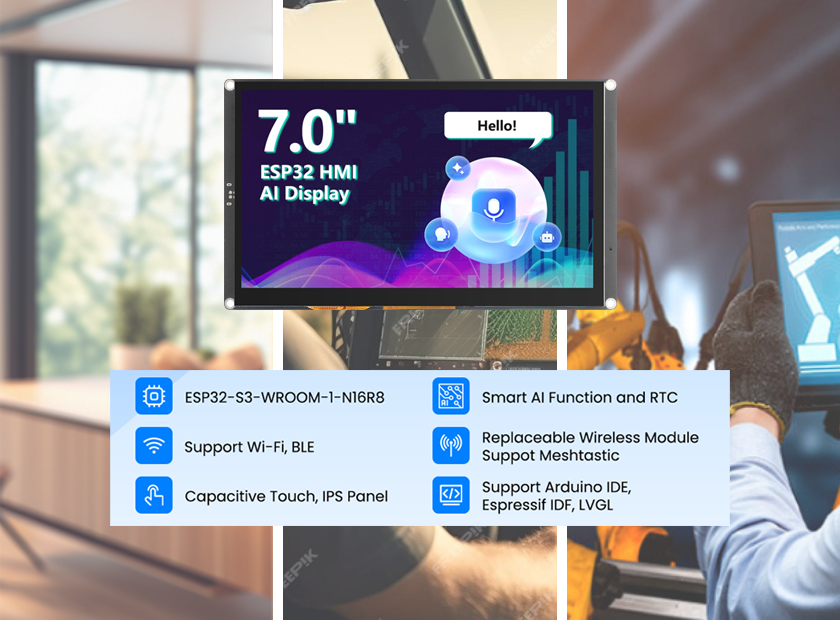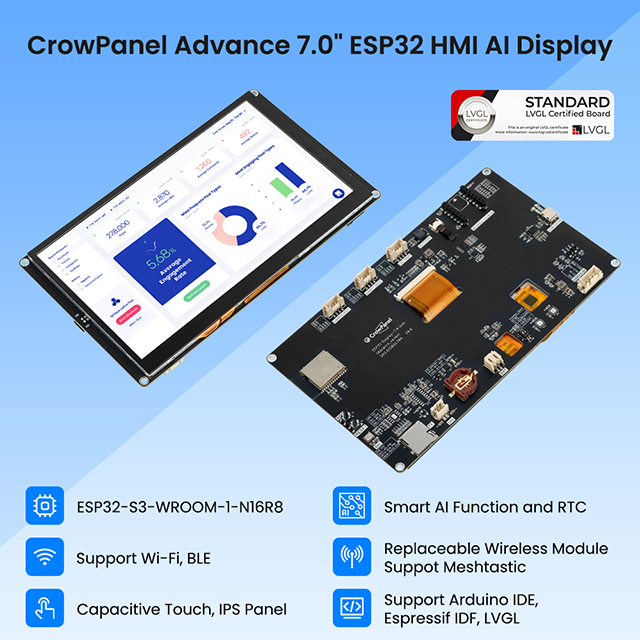Technical Breakthroughs and Applications of Modular IoT HMI Devices

The IoT industry has long faced the challenge of protocol fragmentation, requiring different communication protocols for different scenarios. The modular design concept addresses this by encapsulating mainstream protocols like Wi-Fi and LoRa into standardized, plug-and-play components, significantly lowering the barrier to entry for enthusiasts. This design offers exceptional flexibility: users can insert a Wi-Fi/Matter module for cross-platform smart home control or switch to a LoRa module for long-range agricultural monitoring. Through hardware abstraction, it not only eliminates the need for multiple standalone devices but also reduces multi-protocol development complexity by 70% via a unified SDK interface. Developers can quickly deploy applications without deep knowledge of underlying protocols, while the modular approach protects hardware investments—future upgrades simply require replacing the corresponding module when new standards emerge.
Heterogeneous Computing Architecture for Performance Breakthroughs
A device called CrowPanel, equipped with an ESP32-S3 dual-core processor, adopts an innovative heterogeneous computing architecture that decouples graphics rendering from device control. Specifically, the primary core drives an 800×480 IPS touchscreen with the LVGL graphics engine, paired with an intelligent ambient light adaptation algorithm. This enables seamless transitions from inverse-color display in bright environments to PWM dimming in low light, ensuring optimal visibility under all conditions. The secondary core handles protocol scheduling, using a hardware abstraction layer to manage Wi-Fi/BLE, LoRa (based on the SX1262 chip), and industrial bus communications in parallel, guaranteeing stability and responsiveness during multi-protocol operation.

AI Display
An integrated AI accelerator with vector instruction support allows on-device deployment of lightweight MobileNetV2 models, enabling pest/disease image recognition in milliseconds. With Type-C hot-swappable expansion for LoRa or RS485 modules, CrowPanel maintains just 5.8W power consumption while balancing touch responsiveness and multi-protocol coordination. This makes it equally suitable as a cross-protocol smart home hub or an agricultural edge computing node.
Cross-Protocol Smart Home Control Hub
For personal use, CrowPanel’s 7-inch IPS touchscreen (800×480 resolution) serves as an ideal smart home interface. Its built-in ESP32 module centralizes control of Wi-Fi appliances, Bluetooth sensors, and low-power network devices—eliminating the need for multiple apps and streamlining the user experience.
Notably, its innovative HMI design adapts to real-world scenarios: a physical knob mode activates for wet kitchen conditions, while a gesture-swipe feature allows quick security camera toggling during cleaning. Field tests confirm reliability, stable data updates for over 72 hours even through concrete walls.
 Many different situation
Many different situation
Industrial-Grade Reliability for Agricultural IoT
Agricultural IoT demands ruggedness and environmental resilience. CrowPanel meets this with a fully laminated IPS display supporting 100,000-level brightness adjustment, ensuring readability under direct sunlight for critical parameters like greenhouse humidity and soil EC levels. Its IP65-rated enclosure and shock-absorbing rubber edges withstand moisture, dust, and machinery vibrations.
Functionally, it supports rapid crop growth model imports via SD card and on-device AI pest identification, minimizing cloud dependency. In a real-world deployment at a vineyard, the device maintained 98.7% touch accuracy after six months of outdoor operation—proving exceptional durability.
 AI inside Machine
AI inside Machine
Redefining HMI Expansion and the Future of Modular Architecture
CrowPanel redefines HMI possibilities with features like firmware hot-swapping between interactive and headless modes, catering to diverse use cases. Its "screen-as-a-platform" philosophy has gained traction, with industrial automation vendors already developing customized solutions atop its versatile framework.
Looking ahead, modular architecture holds immense potential. Emerging 5G RedCap and Wi-Fi 7 technologies will only require new plug-in modules to upgrade connectivity. Deeper AI integration could enable protocol selection algorithms to predict network conditions via historical data analysis, enabling intelligent resource allocation.
On the business side, modularity will spur innovations like protocol module leasing and on-demand upgrade plans, offering cost-effective access to cutting-edge tech. This open, evolvable architecture represents the future of IoT—and CrowPanel is leading the charge.
